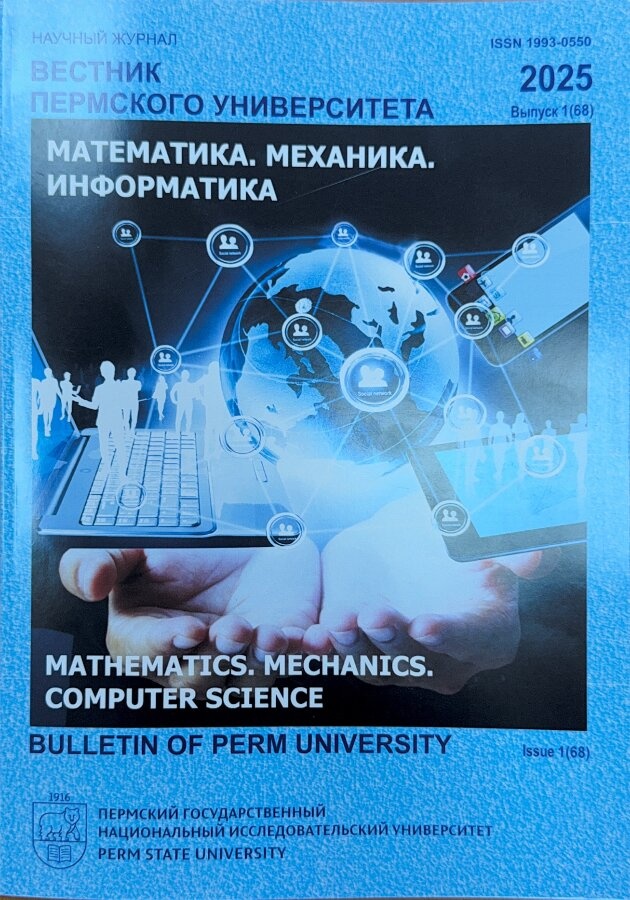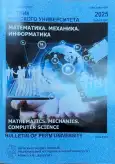Vestnik Permskogo universiteta. Matematika, mehanika, informatika
Dear colleagues, authors and readers, welcome to the scientific journal "Bulletin of Perm University. Mathematics. Mechanics. Computer Science" website!
The journal was founded in 1994 at Perm State University (PSU) and was called "The Bulletin of Perm University". The journal was used by Perm State University researchers from various science fields to publish their works. "The Bulletin of Perm University" publication began on the PSU vice-rector for scientific work Boris Mikhailovich Osovetsky initiative.
Since 2003, the scientific journal "Bulletin of Perm University" has ceased to be common, and each PSU faculty began to publish its own profile journal. Thus, the Mechanics and Mathematics Faculty transformed the journal into an edition called "Bulletin of the Perm University. Series: Mathematics. Mechanics. Computer Science", and later – "Bulletin of the Perm University. Mathematics. Mechanics. Computer Science".
Currently, the journal work has gone beyond Perm University and is devoted to the dissemination of new original scientific results of Russian and foreign researchers in the field of mathematics, mechanics and computer science!
The journal is included in the peer-reviewed scientific publications list for the main research results should be published (Candidate of Sciences and Doctor of Sciences, order dated 07/08/2024).
We invite you to cooperate and hope that you will become our regular author and reader!
Sincerely, the editorial board.
Current Issue
No 1 (68) (2025)
 5-5
5-5


Mathematics
An Analogue of the Euler Equation and Necessary Conditions for Second-order Optimality in an Optimal Control Problem Described by Nonlinear Volterra Integral Equation
Abstract
 6-17
6-17


Mechanics
Formation of Inspection Motion for Spacecraft in Lunar Orbits
Abstract
In this work, the problem of selecting the initial parameters for the relative motion of spacecraft (SC) to ensure and maintain the inspection trajectory is addressed. The study includes modeling the relative motion of two SCs (reference and inspector) in low lunar circular orbits. The orbits for the reference SC considered are known stable and "frozen" orbits, which allowed for the analysis of their applicability in the implementation of inspection tasks. The results of the study demonstrated the presence of three main types of motion of the relative trajectory in the orbital coordinate system: movement along the Ox axis, rotation around the Oy and Ox axes. The use of 15 harmonics of the lunar gravitational potential for the analysis of relative motion of SCs around the Moon was justified. Each relative trajectory was analyzed taking into account deviations along the axes. It was shown that not all stable orbits are suitable for performing inspection tasks. Polar orbits demonstrated their advantages due to greater adaptability and reduced instability of the relative trajectory. It was shown that in non-polar orbits, the effect of increasing the eccentricity of the relative trajectory over time has a significant impact on the inspection movement
 18-27
18-27


Study of Plane Angular Motion of a CubeSat Nanosattellite Using Phase Portraits
Abstract
 28-40
28-40


Investigation of the Influence of Inertial Mass Suspension Structure of Glass Micromechanical Accelerometer on its Properties
Abstract
 41-51
41-51


Gyrostat Motion in the Light Flow of Semi-Euclidean Space
Abstract
The motion of a gyrostat in a stationary field of light pressure forces in semi-Euclidean space is investigated. A gyrostat with kinetic axial symmetry and a constant gyrostatic moment moves so that its carrier rotates around the center of inertia. The field of light pressure forces is generated by a stationary light flux of constant intensity, formed by parallel rays of light, and is assumed to be conservative. Based on an improved thermomechanical model of the dynamic interaction of light radiation with a solid surface, a dynamic system is constructed and the limited problem of studying motion of a special type is considered. As a result of applying an affine transformation of the variables determining the motion of the gyrostat, exact solutions to the problem of integrating a dynamic gyrostat system in a conservative field of light pressure forces were obtained. Two modes of gyrostat motion and their analog interpretation are considered.
 52-66
52-66


Production Peculiarities of Hot-Curing Resin Samples for Potential Use in Open Space Conditions
Abstract
 67-78
67-78


Application of the Method of Multiple Scales to the Problem of Occurrence of Solute Convection in Rectangular Region of Porous Medium
Abstract
 79-90
79-90


Computer science
Basic Algorithm for Automatic Spelling Correction of Russian Texts: Development, Evaluation and Prospects
Abstract
 91-108
91-108


Development of a Servo Control System With Parametric Adaptation for Rotary Test Stands
Abstract
 109-117
109-117


Artificial Intelligence Implementation for Customer Engagement in Social Networks: an Overview of Russian and Foreign Experience
Abstract
In modern realities, artificial intelligence plays a key role in marketing, in general, and certainly in engaging new users in social networks, in particular. Neural networks and other machine learning methods are widely used in various recommendation systems, but their application for attracting new customers is underdeveloped. As we know, upscaling of any business is directly related to increasing the number of new consumers, which determines the significance of studying the issue of neuromarketing. The purpose of this study is to conduct a comparative analysis of existing Russian and foreign services for the engagement of new clients and to identify effective methods used for these purposes.
 118-144
118-144


Methods and Tools for Virtual Semantic Integration of Data from Distributed Heterogeneous Sources
Abstract
 145-159
145-159











